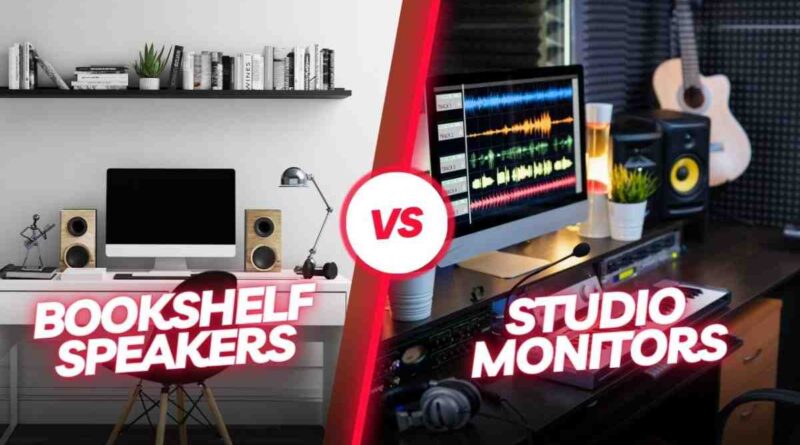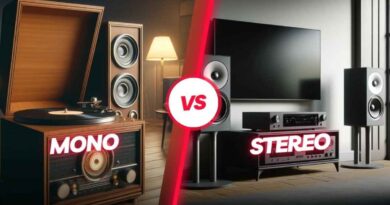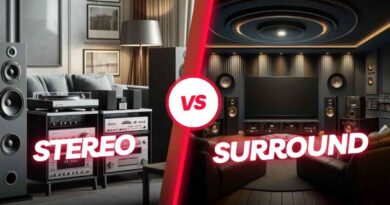Bookshelf Speakers vs Studio Monitors: The Main Difference
When setting up your audio environment, whether it’s for a cozy home listening session or a professional studio setup, the choice between bookshelf speakers and studio monitors can significantly impact your listening experience. As an audio expert with years of experience in sound engineering and speaker design, I’ll guide you through the key differences, technical specifications, and practical applications of both types of speakers to help you make the most informed decision for your needs.
What Are Bookshelf Speakers
Bookshelf speakers are versatile audio devices designed for residential use. They fit conveniently on shelves or stands and are primarily used for enhancing the audio experience in home theaters, living rooms, and personal listening spaces.
Sound Characteristics
- Frequency Response: Bookshelf speakers typically have a frequency response that caters to a wide range of sounds, suitable for different genres of music and multimedia applications. However, they might not capture the extreme lows and highs as effectively as specialized speakers.
- Soundstage and Imaging: These speakers are well-regarded for their ability to create a pleasant soundstage. Imaging, or how well the speakers can sonically place instruments and vocals in a space, tends to be broad and immersive, making them ideal for movies and music.
Design and Aesthetics
- Size and Portability: Generally compact, bookshelf speakers are designed to blend into home decor with ease and subtlety. Their size allows them to be placed on various surfaces without the need for dedicated space.
- Build Quality: While the build quality can vary, most mid to high-end models are constructed with premium materials that enhance both sound quality and durability.
Price and Accessibility
- Cost: Bookshelf speakers are often more affordable than studio monitors, making them an accessible option for the average consumer.
- Availability: You can find them at most electronics retailers, ranging from budget-friendly models to high-end designs.
Key Takeaways:
- Bookshelf speakers are ideal for general home use, offering good versatility across various media.
- They provide a balanced mix of sound quality and aesthetics, making them a practical choice for most consumers.
What Are Studio Monitors
Studio monitors are professional speakers that provide a flat frequency response for accurate audio reproduction. They are essential in environments where sound precision and detail are critical, such as recording studios and editing suites.
Sound Accuracy
- Frequency Response: Studio monitors are engineered to deliver an extremely flat frequency response. This means they do not color the sound, allowing audio professionals to hear mixes and recordings exactly as they are.
- Detail and Clarity: The precision in studio monitors is notable, with every nuance and detail in the audio being clearly presentable. This clarity is crucial for audio editing and mixing tasks.
Design and Functionality
- Size and Form Factor: Unlike bookshelf speakers, studio monitors are often larger and require specific placements, typically at ear level, to perform optimally.
- Build and Material: The construction of studio monitors is robust, often featuring advanced materials and technologies to minimize resonance and distortion.
Professional Use and Price
- Cost: Generally, studio monitors are more expensive than bookshelf speakers, reflecting their specialized use.
- Market Availability: They are less commonly found in consumer electronics stores and more in professional audio equipment outlets.
Key Takeaways:
- Studio monitors are designed for critical listening and professional audio work.
- They offer unmatched accuracy in sound reproduction, which is essential for audio production environments.
Comparison of Power Handling and Efficiency
When evaluating bookshelf speakers and studio monitors, understanding their power handling and efficiency is crucial for determining their suitability for your specific audio needs.
Power Handling
- Bookshelf Speakers: Typically, bookshelf speakers handle less power compared to studio monitors. They are designed to operate effectively within the power range of home audio receivers and amplifiers, making them suitable for average listening volumes.
- Studio Monitors: Designed to endure long hours of operation at varying volumes, studio monitors can handle higher power inputs. This is essential in professional settings where long mixing sessions can push equipment to its limits.
Efficiency and Sensitivity
- Sensitivity: Bookshelf speakers usually have higher sensitivity than studio monitors. This means they can deliver louder audio at lower power inputs, suitable for home use where energy efficiency might be a concern.
- Efficiency: Studio monitors are less about sensitivity and more about providing accurate and consistent output regardless of volume changes. This feature is critical in a studio environment where the accuracy of sound reproduction must be maintained at all times.
Key Takeaways:
- Bookshelf speakers are generally more suitable for home use with moderate power handling and higher sensitivity.
Studio monitors are optimized for professional use, capable of handling more power and maintaining sound accuracy across different volume levels.
Connectivity and Setup
Connectivity options and setup configurations also differ significantly between bookshelf speakers and studio monitors, affecting their integration into various environments.
Connectivity Options
- Bookshelf Speakers: These speakers often feature a range of connectivity options including standard speaker wire, RCA, and sometimes Bluetooth or Wi-Fi for wireless convenience.
- Studio Monitors: Studio monitors typically provide XLR or TRS inputs, which are balanced for interference-free audio transmission, crucial in professional audio settings.
Setup Complexity
- Bookshelf Speakers: The setup is generally straightforward, often compatible with existing home audio systems without the need for additional equipment.
- Studio Monitors: They require more careful placement and potentially additional acoustic treatment and calibration to ensure optimal audio reproduction.
Key Takeaways:
Bookshelf speakers offer versatile connectivity suitable for home use, with easy integration into most audio systems.
Studio monitors provide professional-grade connections and require more complex setup and calibration for best performance.
Durability and Longevity
The build quality, durability, and longevity of speakers are essential factors, particularly if you’re investing in high-quality audio equipment for long-term use.
Materials and Build Quality
- Bookshelf Speakers: These are often made with high-quality woods or dense polymers, but the focus is more on aesthetics than purely on longevity.
- Studio Monitors: Built for the rigors of professional use, studio monitors often feature metal grilles, robust cabinet construction, and components designed to withstand constant use.
Longevity and Maintenance
- Bookshelf Speakers: With proper care, they can last many years, though they may not endure the same level of wear and tear as studio monitors.
- Studio Monitors: Designed for durability, they often last longer under professional conditions and can be easier to repair or upgrade due to their modular design.
Key Takeaways:
- Bookshelf speakers combine functionality with style, suitable for home environments where they face less physical stress.
Studio monitors are built to last, with a focus on enduring professional use and maintaining performance integrity over time.
Impact of Room Acoustics
Room acoustics play a pivotal role in the performance of any speaker system, but the impact varies between bookshelf speakers and studio monitors based on their intended use and design features.
Room Acoustics and Speaker Interaction
- Bookshelf Speakers: These speakers are generally more forgiving in various room setups. They are designed to perform well in typical home environments, which might not be acoustically optimized.
- Studio Monitors: Studio monitors require more consideration regarding room acoustics to ensure accurate sound reproduction. They are sensitive to reflections, absorption, and other acoustic factors, making room treatment necessary in professional settings.
Optimal Placement
- Bookshelf Speakers: Placement flexibility is one of the strengths of bookshelf speakers. They can deliver a satisfactory audio experience even when placed on shelves or near walls.
- Studio Monitors: In contrast, studio monitors demand precise placement, often at ear level and in specific geometric alignments to the listening position, to perform optimally.
Key Takeaways:
- Bookshelf speakers are adaptable to less-than-ideal room conditions, making them suitable for general home use.
- Studio monitors require careful placement and often room treatment to achieve their full potential, aligning with their use in professional settings.
Price to Performance Ratio
When investing in audio equipment, understanding the price to performance ratio is crucial, especially when deciding between bookshelf speakers and studio monitors.
Cost Efficiency
- Bookshelf Speakers: Generally offer a high value for the price, especially for non-professional users. They provide a balanced sound quality suitable for most home environments without the premium price of studio gear.
- Studio Monitors: Although more expensive, studio monitors justify their cost through unparalleled accuracy and reliability in professional audio production settings.
Investment Consideration
- Bookshelf Speakers: For casual listeners or those new to high-fidelity audio, bookshelf speakers serve as an excellent starting point due to their lower cost and ease of use.
- Studio Monitors: For professionals or serious audiophiles, the investment in studio monitors is often seen as necessary for achieving precise audio editing and mixing outcomes.
Key Takeaways:
- Bookshelf speakers are an excellent choice for cost-effective home audio enhancements.
- Studio monitors, while pricier, offer the precision required for professional audio work, making them a worthy investment for serious users.
Ideal User Scenarios
Identifying the ideal user scenarios for both bookshelf speakers and studio monitors can help potential buyers make an informed choice based on their specific audio needs and environments.
Home Audio Enthusiasts
- Bookshelf Speakers: Perfect for users looking for a significant upgrade from standard built-in speakers or who enjoy a variety of media like music, movies, and gaming in a home setting.
- Studio Monitors: While they can be used at home, they might be overkill unless the user is particularly keen on audio production or demands the highest fidelity in music listening.
Professional Audio Producers
- Studio Monitors: Essential for professionals who require precise sound for critical listening tasks, such as mixing and mastering music tracks.
- Bookshelf Speakers: May serve as a secondary option in a professional setup for less critical listening or leisure.
Key Takeaways:
- Bookshelf speakers are versatile for general home use, catering to a wide audience.
- Studio monitors are targeted more towards professionals in the music and audio production industry, where accuracy and detail are paramount.
Conclusion: Which is the Best Choice?
Deciding between bookshelf speakers and studio monitors ultimately depends on your specific needs, listening environment, and budget. For most home listeners who enjoy a variety of audio content, bookshelf speakers offer an excellent balance of performance, aesthetic appeal, and cost. They provide more than adequate sound quality for enjoying music, movies, and games in a typical home setting.
However, if you are involved in music production or any form of professional audio work, studio monitors are indispensable. Their accuracy in sound reproduction ensures that you can make precise adjustments to your mixes, leading to professional-quality output.
Each type of speaker serves its purpose excellently within its intended environment, making the “best” choice the one that aligns perfectly with your personal and professional audio demands.
Frequently Asked Questions
What are bookshelf speakers best used for?
Bookshelf speakers are best used for home audio setups, including music listening, movie watching, and gaming.
Why choose studio monitors?
Choose studio monitors for professional audio work where accurate sound reproduction is crucial, such as in music production.
Can studio monitors be used for home audio?
Yes, studio monitors can be used for home audio, especially if high fidelity sound is a priority, though they may require more setup and room treatment.
Are bookshelf speakers good for a small room?
Yes, bookshelf speakers are ideal for small rooms due to their compact size and flexible placement options.
Do I need a subwoofer with bookshelf speakers?
Depending on your bass requirements, adding a subwoofer can enhance the low-end response of bookshelf speakers.
Can I mix using bookshelf speakers?
While possible, mixing on bookshelf speakers is not recommended due to their less accurate sound reproduction compared to studio monitors.
Are studio monitors worth the extra cost?
For audio professionals, studio monitors are worth the extra cost due to their precision in sound critical for professional tasks.
How long do studio monitors last?
With proper care, studio monitors can last many years, even under rigorous use conditions.
What is the price range for high-quality bookshelf speakers?
High-quality bookshelf speakers can range from $100 to over $1,000, depending on the brand and features.
What should I look for when buying studio monitors?
Look for monitors with a flat frequency response, appropriate power handling, and connectivity options that suit your studio setup.




